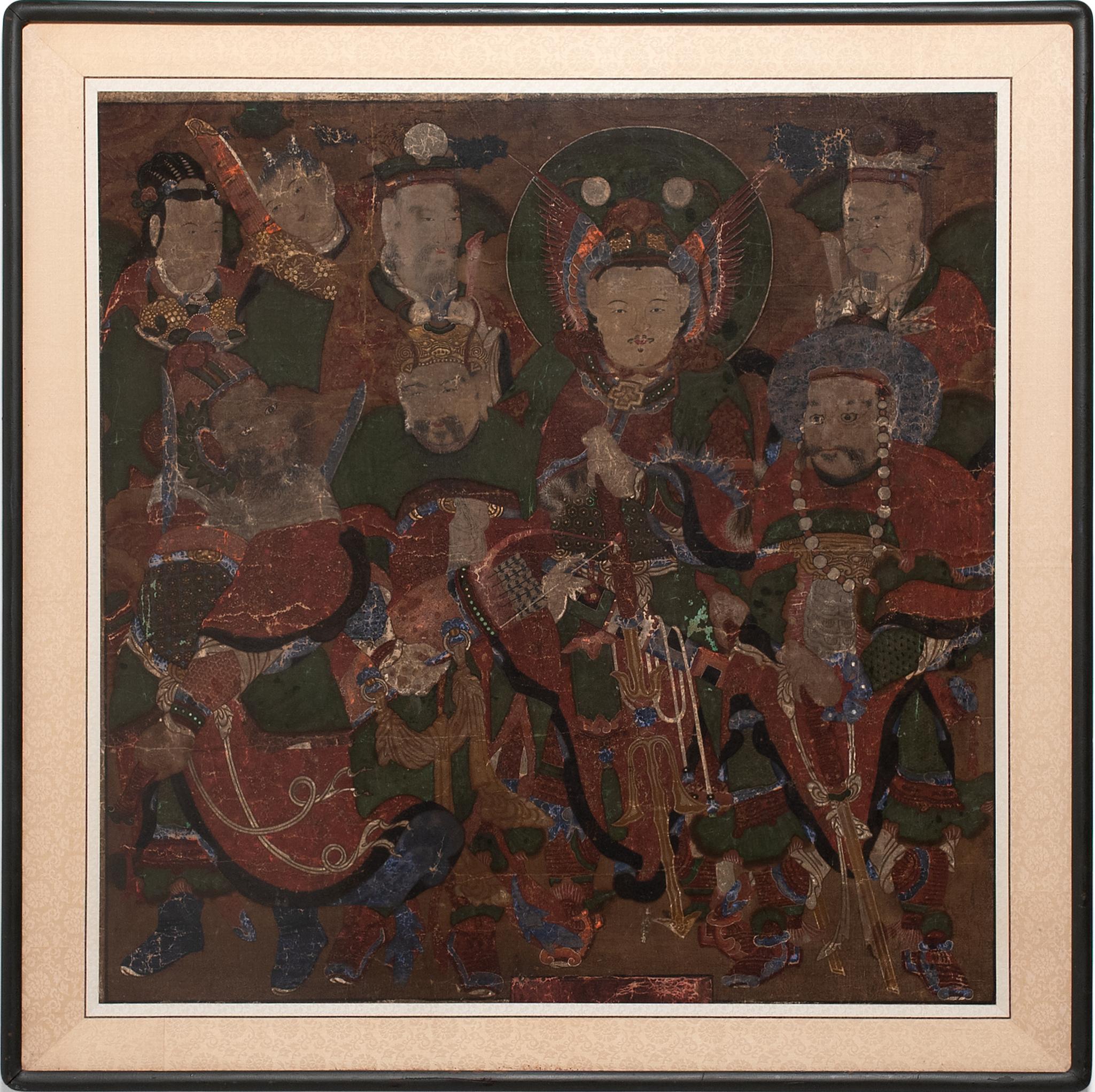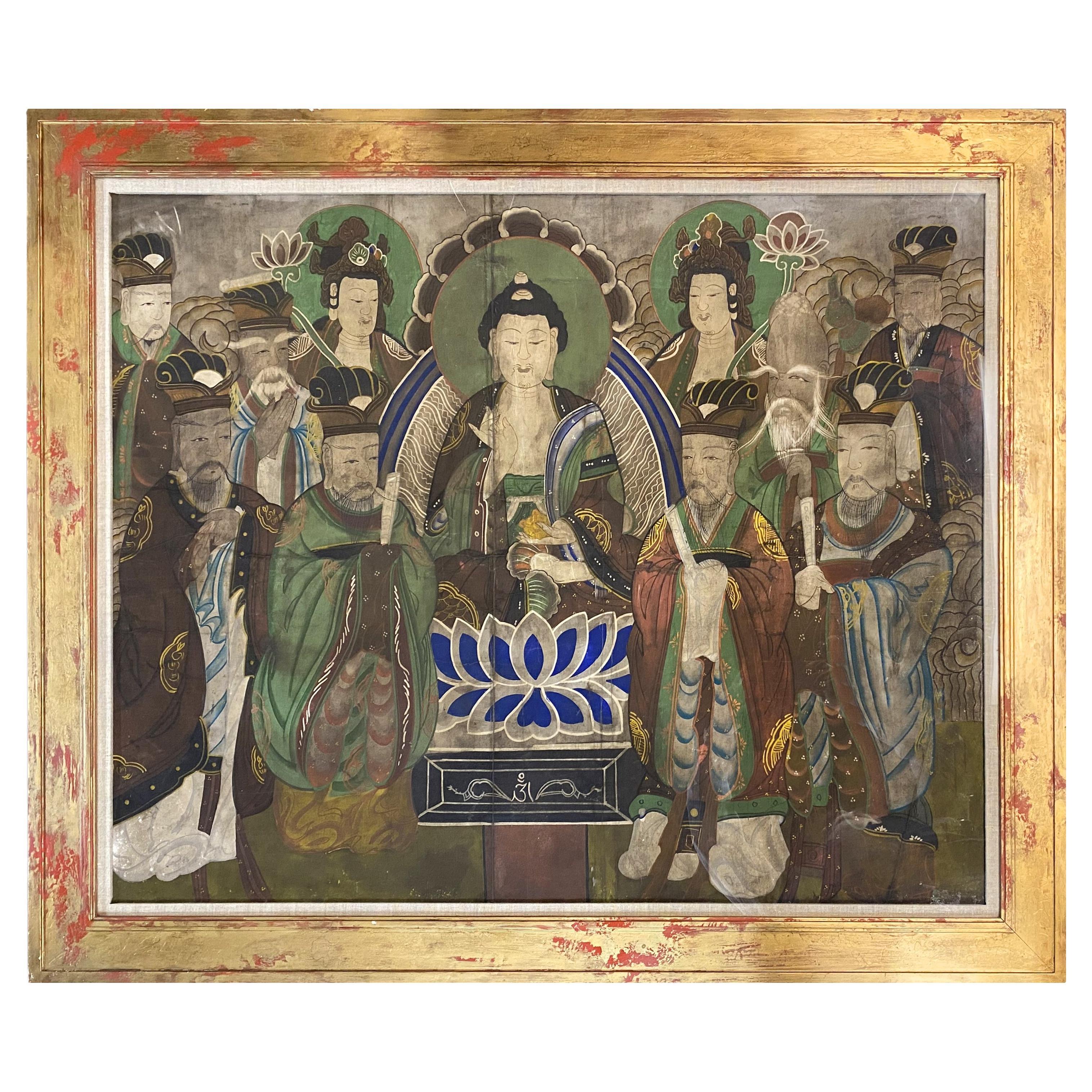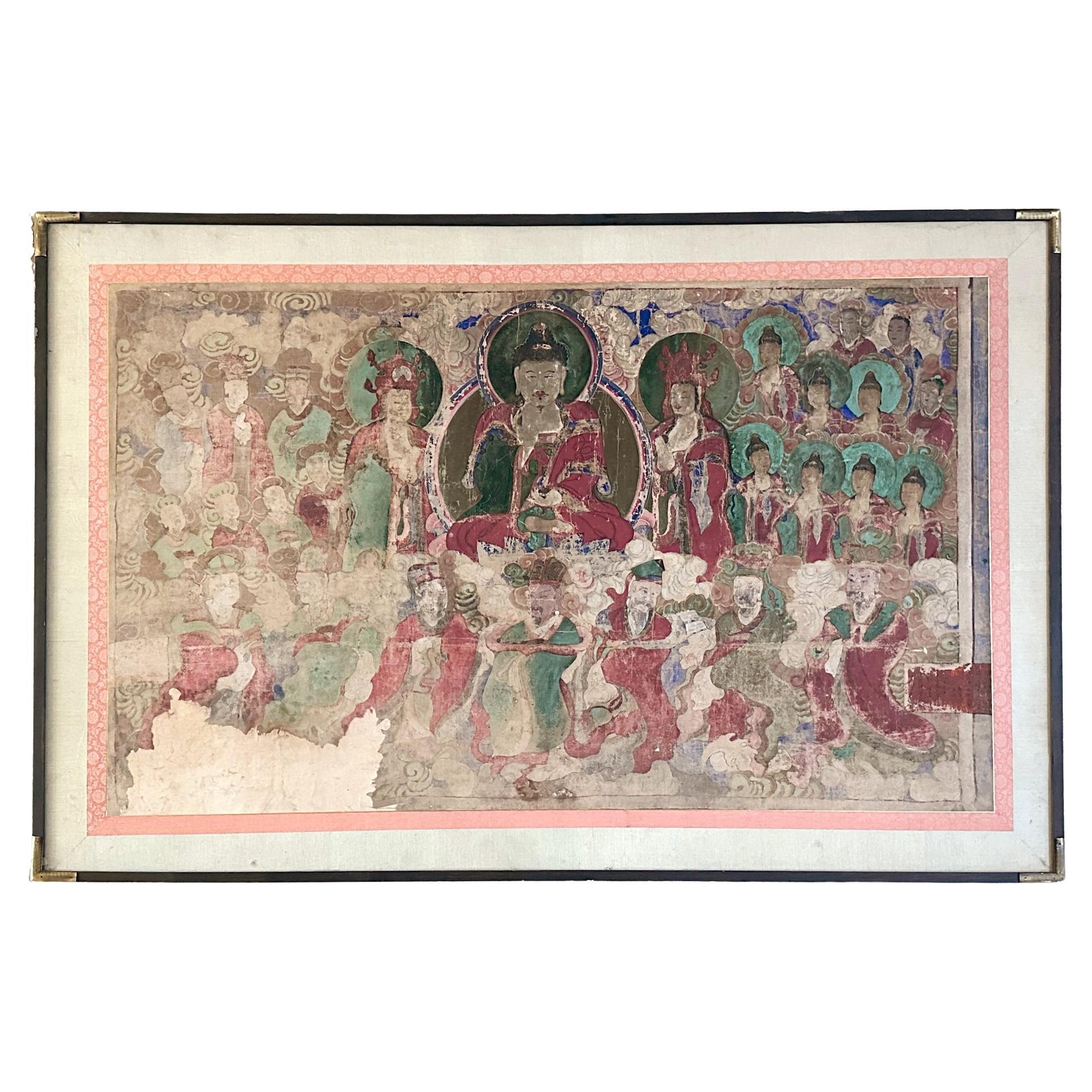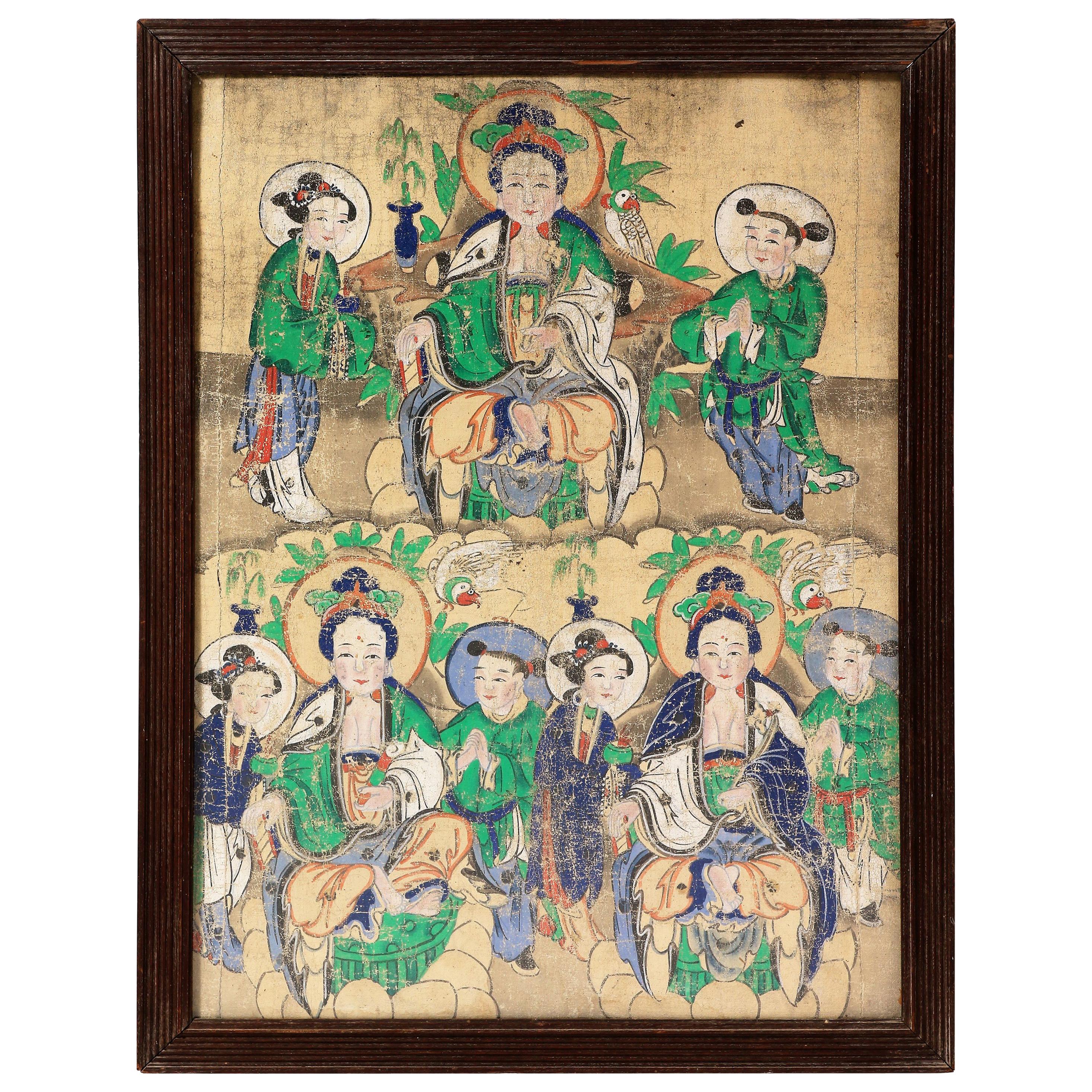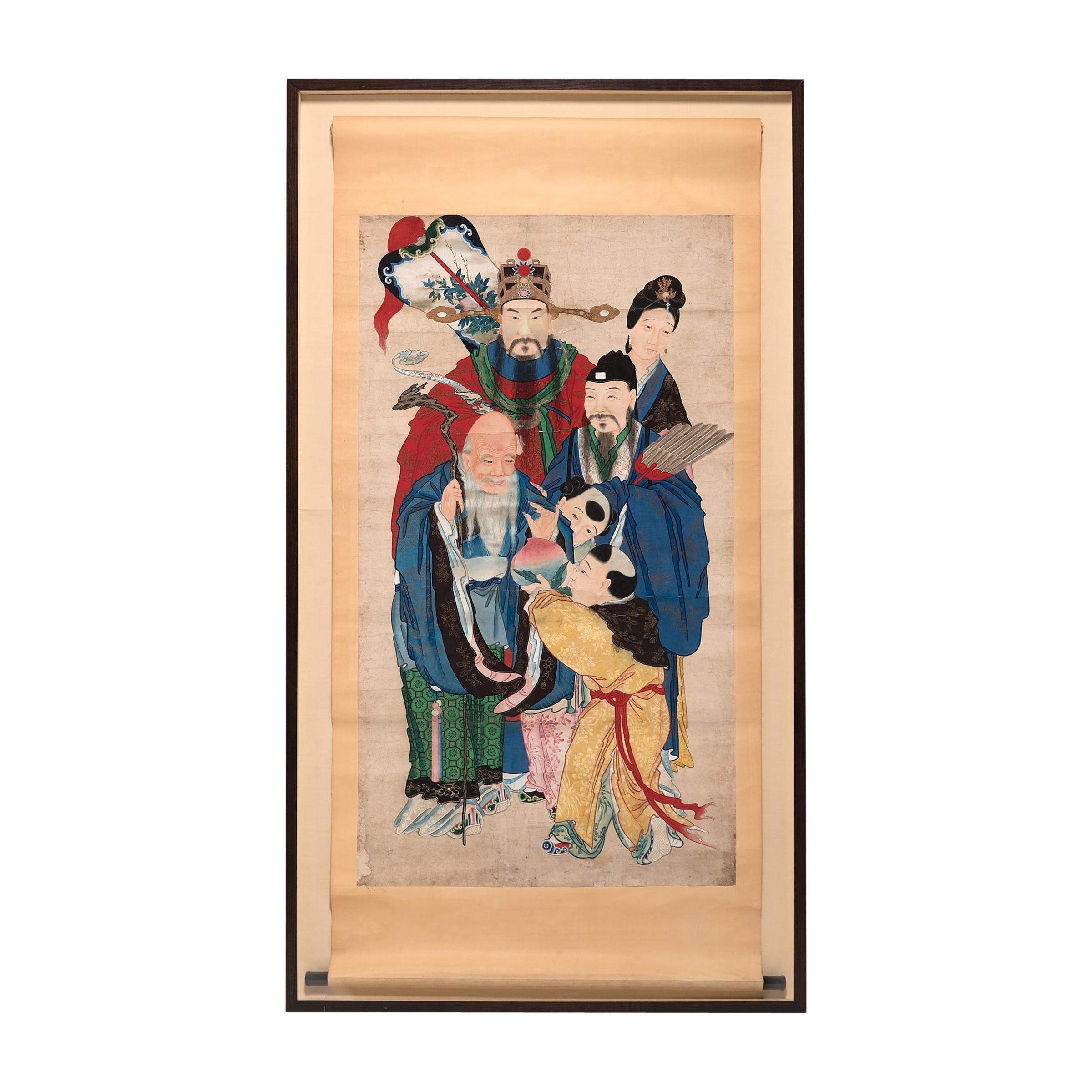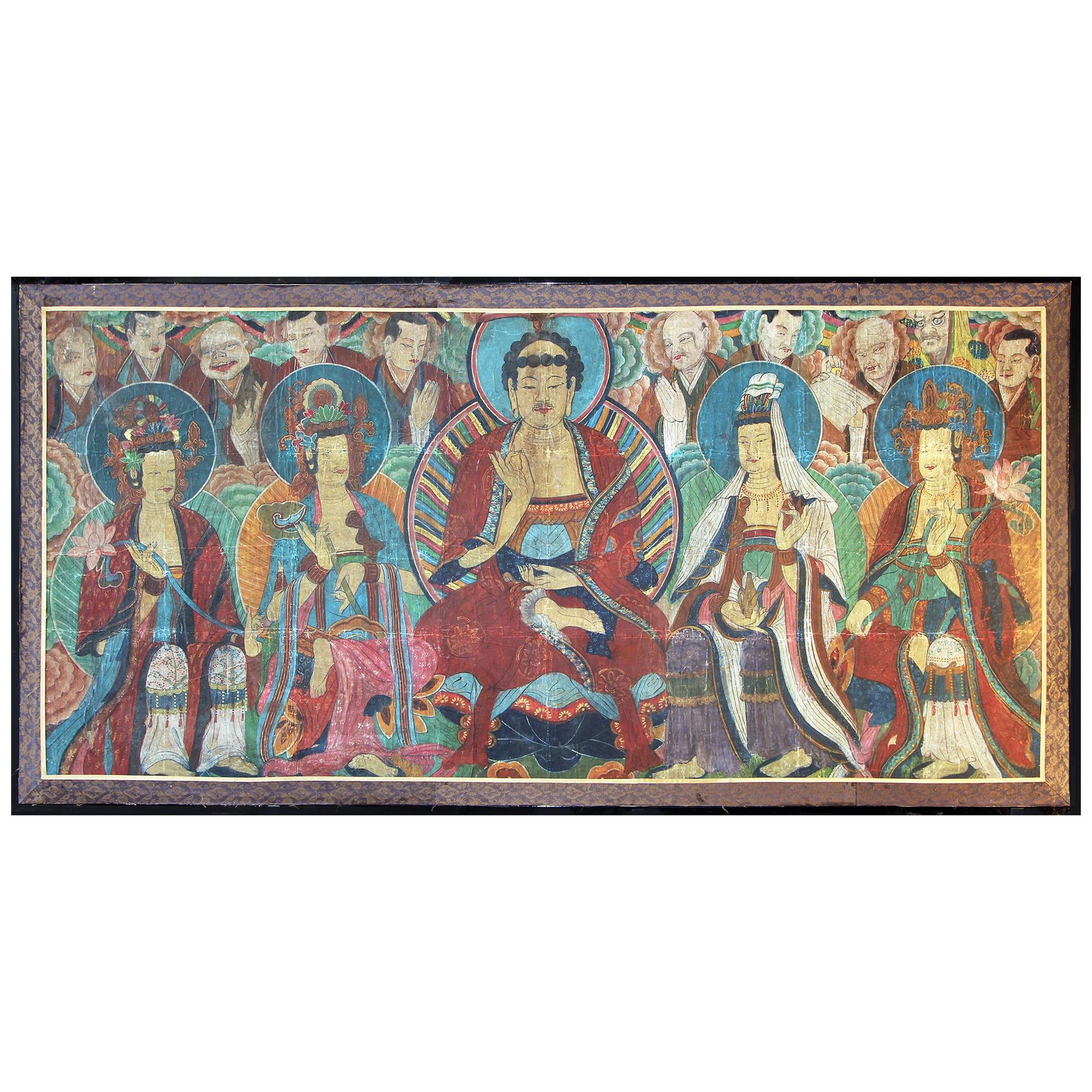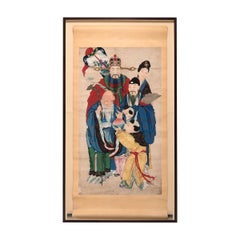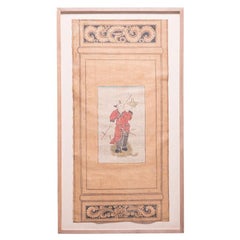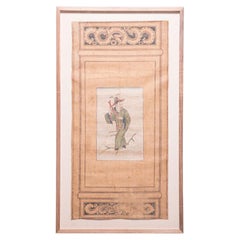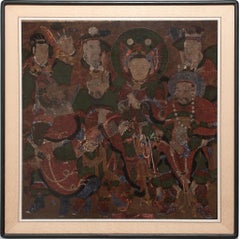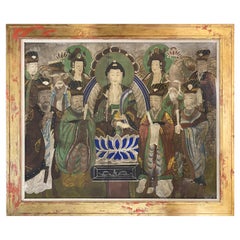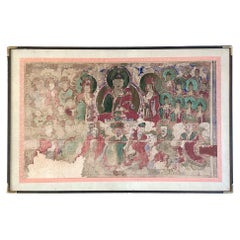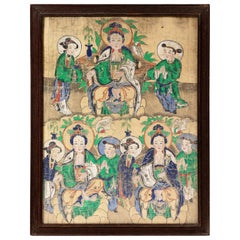Items Similar to Korean Buddhist Guardian Mural Taenghwa Painting, c. 1800
Want more images or videos?
Request additional images or videos from the seller
1 of 5
Korean Buddhist Guardian Mural Taenghwa Painting, c. 1800
$8,800
£6,677.24
€7,634.82
CA$12,291.21
A$13,666.16
CHF 7,135.71
MX$166,350.41
NOK 91,048.59
SEK 85,308.18
DKK 56,980.10
Shipping
Retrieving quote...The 1stDibs Promise:
Authenticity Guarantee,
Money-Back Guarantee,
24-Hour Cancellation
About the Item
Evolving from the Korean tradition of tomb mural painting came the Buddhist practice of “taenghwa,” or hanging-painting, a form of religious painting that included hanging scrolls, framed paintings and wall murals. Influenced by Chinese and Central Asian Buddhist art, taenghwas were painted with Buddhist iconography and were used in Buddhist temples as visual aids during rituals and meditation. The earliest surviving examples of taenghwa date to the early 13th century and were composed of silk gauze and mineral colors. These paintings would portray images of prominent Buddhas and bodhisattvas or depict stories from Buddhist scripture. This example dates to the later Joseon dynasty (1392-1910), a period wherein the presiding Confucian government gradually suppressed Buddhist institutions, resulting in a stylistic shift in taenghwa painting towards brighter colors, smaller scales and simpler materials.
This example is a form of shinjung taenghwa (신중탱화), which loosely translates to “altar painting of guardian deities,” or “guardian mural” for short. The central figure, wearing a feathered headdress and illuminated by a halo, is Tongjin Posal, or Skanda, a bodhisattva charged with protecting the Lotus Sutra of the True Law, one of the most revered of all Mahāyāna Buddhist texts. Typically placed above the middle altar of a Buddhist temple, the shinjung taenghwa houses the lesser deities and Tongjin Posal is commonly positioned in the center as their defender. The figures surrounding Tongjin Posal are various heavenly gods and goddesses who together comprise the sinjung, or Host of Spirits. Painted with gouache pigments in a dark palette of red, green, brown and blue, this taenghwa is a beautiful example of this traditional art form, composed with incredible movement, intricate detailing and rich symbolism.
Gouache paint on cotton. Framed.
Significant fading due to age. Some creasing.
- Dimensions:Height: 1 in (2.54 cm)Width: 42 in (106.68 cm)Depth: 42 in (106.68 cm)
- Materials and Techniques:
- Place of Origin:
- Period:
- Date of Manufacture:c. 1800
- Condition:Wear consistent with age and use. Minor losses. Minor fading.
- Seller Location:Chicago, IL
- Reference Number:Seller: CEC0011stDibs: LU820036160292
About the Seller
5.0
Platinum Seller
Premium sellers with a 4.7+ rating and 24-hour response times
Established in 1997
1stDibs seller since 2006
1,695 sales on 1stDibs
Typical response time: 1 hour
- ShippingRetrieving quote...Shipping from: Chicago, IL
- Return Policy
Authenticity Guarantee
In the unlikely event there’s an issue with an item’s authenticity, contact us within 1 year for a full refund. DetailsMoney-Back Guarantee
If your item is not as described, is damaged in transit, or does not arrive, contact us within 7 days for a full refund. Details24-Hour Cancellation
You have a 24-hour grace period in which to reconsider your purchase, with no questions asked.Vetted Professional Sellers
Our world-class sellers must adhere to strict standards for service and quality, maintaining the integrity of our listings.Price-Match Guarantee
If you find that a seller listed the same item for a lower price elsewhere, we’ll match it.Trusted Global Delivery
Our best-in-class carrier network provides specialized shipping options worldwide, including custom delivery.More From This Seller
View AllChinese New Year Painting, c. 1900
Located in Chicago, IL
In celebration of the lunar New Year festival, it was traditional all over China to hang special decorations. In a city called Wuqiang, local artists made lacquer scroll paintings laden with symbolism. This framed and finely rendered early 20th century folk painting from Wuqiang features an imperial court official and his family dressed in their best silks. The young boy is dressed in a wonderfully patterned yellow robe to offer Shou Xing...
Category
Early 20th Century Chinese Qing Paintings and Screens
Materials
Paper
Chinese Mythical Immortal Screen Painting, c. 1850
Located in Chicago, IL
Since the 12th century, people in China have used folding screens and doors to partition and decorate their homes - the vivid scenes backing the screens added life and color to a roo...
Category
Antique Mid-19th Century Chinese Paintings
Materials
Fabric, Paint
Chinese Mythical Immortal Screen Painting, c. 1850
Located in Chicago, IL
Since the 12th century, people in China have used folding screens and doors to partition and decorate their homes - the vivid scenes backing the screens added life and color to a room. This 19th-century painting is delicately brushed of gouache and ink on fabric and was originally part of a set of eight backing a wooden screen in northern China.
The figure depicted is one of the mythical Eight Immortals of Taoism. Said to have attained immortality through their studies of the natural world, each of the Eight Immortals represents a different condition in life and together they impart a blessing of prosperity and longevity. Depicted here is immortal Lan Caihe, the patron saint of florists and gardeners. Standing atop a lotus leaf in open water, they hold a gardening hoe in one hand and a basket for flowers...
Category
Antique Mid-19th Century Chinese Paintings
Materials
Fabric, Paint
Chinese Mythical Immortal Screen Painting, c. 1850
Located in Chicago, IL
Since the 12th century, people in China have used folding screens and doors to partition and decorate their homes - the vivid scenes backing the screens added life and color to a roo...
Category
Antique Mid-19th Century Chinese Paintings
Materials
Fabric, Paint
Framed Chinese Ancestor Portrait, circa 1900
Located in Chicago, IL
This intricately detailed composition is a late-Qing dynasty ancestor portrait depicting several generations of a family's male ancestry. Or...
Category
Early 20th Century Chinese Qing Paintings and Screens
Materials
Silk
Tibetan Thangka of Vaishravana, c. 1850
Located in Chicago, IL
Thangkas are devotional paintings displayed by Buddhists in monasteries, temples, and even their homes. This 19th-century Tibetan Thangka is rich with historical figures and symbolism arranged around the Viashravana in the painting's center. This lesser deity is the god of wealth...
Category
Antique Mid-19th Century Chinese Tibetan Paintings and Screens
Materials
Fabric, Paint
You May Also Like
Korean Buddhist Guardian Mural Taenghwa Painting, c. 1800
Located in Chicago, IL
Evolving from the Korean tradition of tomb mural painting came the Buddhist practice of “taenghwa,” or hanging-painting, a form of religious painting that included hanging scrolls, framed paintings and wall murals. Influenced by Chinese and Central Asian Buddhist art...
Category
19th Century Folk Art Figurative Paintings
Materials
Cotton, Paint, Pigment
18th/19th Century Korean Buddhist T’aenghwa Painted Scroll or Banner in Frame
Located in Milford, NH
A fine Korean Buddhist T’aenghwa scroll painting, similar to the Tibetan Thangka paintings. The Korean name taenghwa is very similar to the Tibetan word thangka and the period of pop...
Category
Antique 18th Century Korean Paintings
Materials
Canvas
Korean Buddhist Temple Scroll Painting Sinjung T'aenghwa Joseon Dynasty
Located in Atlanta, GA
A large Korean Buddhist painting on silk framed in wood with an acrylic shadow box. The type of the painting is known in Korean as Sinjung T'aenghwa (Literally translated as Scroll-s...
Category
Antique 1880s Korean Other Paintings and Screens
Materials
Silk, Acrylic, Wood
Immortal He Xiangu Painting on Canvas, China, 19th Century Asian Art
Located in Beuzevillette, FR
Chinese painting depicting He Xiangu reproduced three times but with a different attribute: up a lotus flower, bottom left a fly hunt and bottom right again the lotus flower, each time surrounded by disciple the one praying right, the one on the left seems to bring him a bowl.
Pigments on linen or hemp,
19th century.
He Xiangu or Ho Hsien-ku, "Immortal Demoiselle He," is an immortal Taoist, a member of the group of Eight Immortals. She is represented holding in her hand a lotus symbolizing spiritual fulfillment, and sometimes also a sheng, a peach of immortality, a wooden ladle...
Category
Antique 19th Century Chinese Qing Paintings and Screens
Materials
Canvas
Big Size Buddhist Painting
Located in Brescia, IT
Painting on natural-colored paper, depicting many characters from the Buddhist pantheon.
These images of Buddha and bodhisattvas depicted stories from Chinese Buddhist scriptures and...
Category
Antique Early 19th Century Chinese Qing Paintings and Screens
Materials
Paper
$10,792
Large Antique Chinese Deity Scroll Painting 19th C
Located in Big Flats, NY
An oversized antique Chinese scroll painting offers depiction of deity with figures, 19th century
Measures - 69" x 26.5"
Catalogue Note: ...
Category
Antique 19th Century Asian Paintings and Screens
Materials
Paper
$760 Sale Price
20% Off
More Ways To Browse
Hanging Scrolls
Korean Traditional Furniture
Antique Cotton Scale
Chinese Guardian
Red Chinese Screen
Chinese Wall Screens
Feather Headdress
Asian Screens Green
Small Asian Screens
Temple Guardian
Altar Frame
Asian Painted Scrolls
Antique Wall Mural
Antique Wall Murals
Buddha Wall
Lotus Screen
Buddhist Altar
19th Century Chinese Painting On Silk
